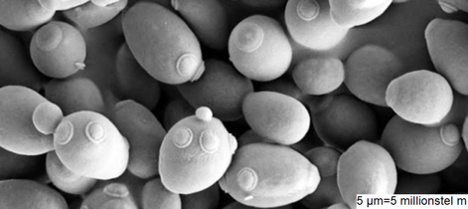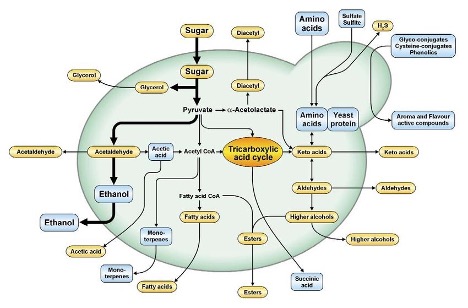Saccharomyces cerevisciae, a brief review
Joy Ting
April 2020

Saccharomyces cerevisiae, the humble yeast, is really the hero of winemaking. Without it, there would be no wine, only sour grapes! It is Saccharomyces that fends off Hanseniaspora and other spoilers and completes the work of fermenting sugar to alcohol. In the process, the mighty Saccharomyces also transforms precursors into volatile aromas, and sacrifices its dying body to provide nutrients for malolactic bacteria, all while donating mannoproteins for mouthfeel. Though domesticated thousands of years ago, this yeast maintains enough genetic diversity to literally fill a catalogue! But how is a winemaker to choose? Does yeast strain even matter? There’s one way to find out… do an experiment!
Saccharomyces cerevisiae was first identified as the agent of fermentation by Louis Pasteur in 18601, however, this species has been around for a lot longer than that. Based on similarity in genetic sequences, it is thought that Saccharomyces cerevisiae as we know it arose from a single domestication event in ancient Mesopotamia, around the same time as the domestication of grape vines. From there, it spread around the world along with the vines that produce its food source. There are 5 distinct genetic lineages of Saccharomyces cerevisiae: West African, Malaysian, North American, Sake, and European. Wine yeast, whether commercial or ambient, all belong to the European group, indicating that technological usage is more important than geography in the genetic history of this organism. There do not appear to be separate genetic patterns for vineyard vs. winery strains of S. cerevisiae, suggesting the two populations mix freely, probably mediated by movements of insects and humans as well as dumping of pomace (1).
Saccharomyces cerevisiae most likely originated from the sap and bark of oak trees and possibly the soil underneath those trees. It may be the offspring of Saccharomyces paradoxus and/or S. uvarum, as they share this native habitat (2). S. cerevisiae are only a minor member of the community of microbes found on grapes, often below the level of detection when these communities are surveyed. When fruit is damaged or seepage occurs, the conditions for growth improve, and Saccharomyces can be found in increasing numbers (1,2). In the winery, however, this yeast dominates, where it can be found in significant numbers on winery equipment and coating the walls themselves. The concentration of yeast cells found in the winery rivals the overall concentration of microbes found on grapes, often providing significant inoculum for both spontaneous and inoculated fermentations. When surveyed, it is common to find one or a few strains dominating a single winery, with limited geographic spread outside the winery (into the vineyard), while it is rare to find whole regions dominated by the same few strains. Resident strains do, however, shift from year to year (2).

from Wein-Plus glossary, Saccharomyces, by Megan, edited by Tischelmayer, 2018
The genetic code of domesticated Saccharomyces cerevisiae contains some clues to its secrets for dominance in wine fermentation. For example, the use of SO2 as an antimicrobial agent was likely introduced sometime between the Roman Empire and the Middle Ages. Around this time, there was a chromosomal rearrangement in one lineage of S. cerevisiae that led to a dominant allele for a sulfite pump, conferring a high level of SO2 resistance to the cells. This single innovation was so beneficial to the cells that have it that now 50% of modern isolates from wine carry this genetic signature. A similar bottleneck can be found for copper resistance genes arising around the time of copper introduction in the vineyard (1).
Despite its long history of domestication and these bottlenecks, Saccharomyces cerevisiae as a species includes a tremendous amount of genetic diversity that leads to a diverse set of responses to environmental stimuli, and results in real differences in fermentation kinetics, aromatic production, and other characteristics of the resulting wine. Regardless of the strain, all yeast convert sugar (glucose and fructose) to ethanol as a way of releasing energy for the cells to use to build cell structures and maintain order. This is done by a series of enzymatic reactions happening inside the cell. Each enzyme is encoded by a gene, which may have slight differences from the same gene in a different strain. These genetic differences may make that enzyme faster or slower, favor one substrate over another, or even nonfunctional. These differences add up over many thousands of enzyme reactions within the cell. Strains may also have genetic differences that make them more or less likely to respond to outside stimuli, such as a change in temperature or the presence of a competing microbe. For the cell, these may mean the difference between dominance and extinction in a given fermentation; for the winemaker, this may mean differences in aromatic profile or completion of the fermentation.

from Yeast and bacterial modulation of wine aroma flavor, Australian Journal of Grape and Wine Research, January 2005)
Much of the aroma and flavor of wine stems from the byproducts of fermentation and its side reactions, and genetic differences among strains leads to differences in the level of production of any given metabolite. Some known examples of enzyme derived aroma and flavor molecules include (2):
- The release of volatile terpenes, norisoprenoids, and thiols by the enzymatic cleavage of sugar molecules from non-volatile precursors
- Production of acetic acid, acetoin, and succinic acid as byproducts of fermentation
- Release of acetate esters due to accumulation of Acetyl Co A
- Release of higher alcohols as amino acids in the juice are broken down for nitrogen
- Production of aroma precursors from fatty acid production in cell walls based on environmental conditions (temperature)
- Increase in glycerol production due to overexpression of glycerol-3-phosphate dehydrogenase. This also leads to accumulation of acetaldehyde, pyruvate, acetate 2,3, butanediol, succinate, and acetoin
A useful example of the impact of genetic variation is provided by Linda Bisson (2012)1 as she describes the superpowers of EC118 (aka Prise de Mousse). This strain is known as a steady fermenter, a good choice when it is essential that the fermentation finish with good kinetics. Among the reasons EC118 is so steady are the variants of transport proteins it houses in its cell membranes. This strain has a better peptide transporter than most, which means it does a better job of taking up organic nitrogen resources from the environment. The cell breaks down these amino acids by stripping nitrogen for its own use, leaving amino acid side chains that can be converted to higher alcohols and esters, i.e. aromas and flavors. EC118 also contains a gene for a fructose proton symporter, which means that it can transport fructose into the cell in the flow of protons. Many yeast have transport proteins that take up glucose preferentially, leaving leftover fructose (residual sugar) at the end of fermentation (1). This yeast is not perfect, however. It is also thought to produce relatively high levels of SO2 during alcoholic fermentation, which can inhibit malic acid bacteria.
The genetic diversity of Saccharomyces is such that no one strain accurately portrays the whole species (1). And it is this diversity that can become a valuable tool for the winemaker. A quick glance at the Scottlabs catalogue indicates there is a yeast strain for nearly every fermentation. Want to increase thiol release from percursors? There is a yeast for that! Want to break down proteins, produce fruit esters, stabilize color… there are yeast strains for that too! The diversity of commercial yeast strains that have been isolated, cultured and characterized can be overwhelming, but also exciting. Caution must be taken to choose appropriate strains for the situation, including temperature and alcohol tolerances, as well as nutrient needs. And, as Jackson (2014) points out, “the main characteristics of most commercial strains are known, but most of their other properties are not…It is once again up to the winemaker to do their own individual experimentation to determine what best suits their situations and preferences” (2).
References
(1) Bisson, L. F. Geographic Origin and Diversity of Wine Strains of Saccharomyces. American Journal of Enology and Viticulture 2012, 63 (2), 165–176. https://doi.org/10.5344/ajev.2012.11083.
(2) Jackson, R. S. Wine Science: Principles and Applications, 4 edition.; Academic Press: Amsterdam, 2014.
